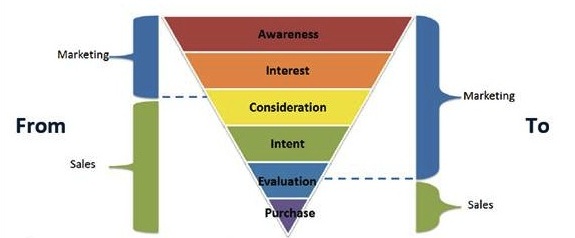Everybody knows fluffernutter sandwiches are delicious. And they’re where fluff belongs. For a long time, marketing teams struggled to measure and prove their value. Sometimes, this led to an over-reliance on “fluffy” metrics like “awareness” or “brand image.” Now, though, new buying behavior cuts deep into the fluff and extends the marketing arm way into the sales cycle and more sophisticated tracking tools are providing hard data on marketing’s contribution to the bottom line. Clearly, marketing is becoming busier (and less fluffy) than ever.
But at the same time, the bottom line is getting much more complicated. For example, there used to be two simple sales paths for software buyers to follow – B2B and B2C. For either path, marketers were responsible for building awareness and interest to guide buyers into a sales funnel, where salespeople took over, built up intent, helped provide a framework for evaluation, and eventually handled the purchase. The process looked like the left side of this diagram:
The fact that marketing covered less area also meant that it had fewer metrics to support its success. But now, software purchasing paths are expanding in new directions as modern software buyers educate and lead themselves instead of taking direction from sales teams. This means that B2B and B2C approaches are in some ways relics of the past, and an unprecedented number of points of discovery and resources – from Twitter chats to free content to help documentation – are empowering the modern B2i software buyer to make decisions independently, without aid from sales teams.
In fact, the CEB Marketing Leadership Council has found that customers will only contact sales representatives once they’re 60% of the way through the purchasing process – much farther along than in the past. The shift toward B2i has made the new buying process look more like the right side of the image above. Marketers are taking over more sales functions, interacting with customers more frequently, through many channels and providing information that guides customers all the way through to making actual purchases or trials.
As buyers interact with more marketing touch points, marketers can gather larger troves of data about the effectiveness of their campaigns. They can then use each data point to identify and appeal to each customer’s individual preferences with custom messaging – and, in turn, prove the value of different marketing efforts by tracking precisely what and when customers actually buy.
In fact, software sales have evolved so much that software sometimes seems to “sell itself”. A big part of marketing now centers on delivering value by educating customers through self-service tools, available at any time, from anywhere. These not only let customers create their own custom software suites (in some cases at least), but also make marketers smarter and more efficient. You could even say that marketing is teaching customers how to make their own sandwiches – no fluff involved. That’s a tasty outcome for everyone with a stake in software sales.






